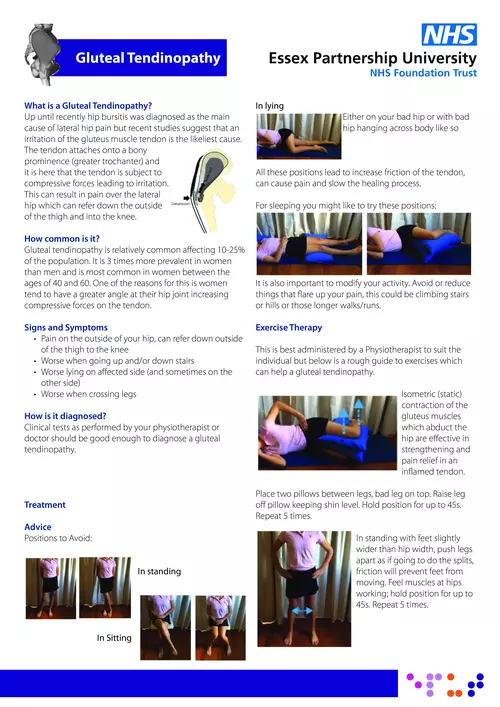
Gluteal Tendinopathy - EPUT
individual but below is a rough guide to exercises which can help a gluteal tendinopathy. Isometric (static) contraction of the gluteus muscles.
adsPart of the document
What is a Gluteal Tendinopathy?
Up until recently hip bursitis was diagnosed as the main
cause of lateral hip pain but recent studies suggest that an
irritation of the gluteus muscle tendon is the likeliest cause.
The tendon attaches onto a bony
prominence (greater trochanter) and
it is here that the tendon is subject to
compressive forces leading to irritation.
This can result in pain over the lateral
hip which can refer down the outside
of the thigh and into the knee.
How common is it?
Gluteal tendinopathy is relatively common a?ecting 10-25% of the population. It is 3 times more prevalent in women
than men and is most common in women between the
ages of 40 and 60. One of the reasons for this is women
tend to have a greater angle at their hip joint increasing
compressive forces on the tendon.
Signs and Symptoms
•
Pain on the outside of your hip, can refer down outside
of the thigh to the knee
•
Worse when going up and/or down stairs
•
Worse lying on a?ected side (and sometimes on the
other side)• Worse when crossing legs
How is it diagnosed?
Clinical tests as performed by your physiotherapist or
doctor should be good enough to diagnose a gluteal
tendinopathy.
Treatment
Advice
Positions to Avoid:
In standing
In Sitting
In lying
Either on your bad hip or with bad
hip hanging across body like so
All these positions lead to increase friction of the tendon, can cause pain and slow the healing process.
For sleeping you might like to try these positions:
It is also important to modify your activity. Avoid or reduce
things that ?are up your pain, this could be climbing stairs
or hills or those longer walks/runs.
Exercise Therapy
This is best administered by a Physiotherapist to suit the
individual but below is a rough guide to exercises which
can help a gluteal tendinopathy.
Isometric (static)
contraction of the
gluteus muscles
which abduct the hip are e?ective in
strengthening and
pain relief in an
in?amed tendon.
Place two pillows between legs, bad leg on top. Raise leg
o? pillow keeping shin level. Hold position for up to 45s.
Repeat 5 times.
In standing with feet slightly
wider than hip width, push legs
apart as if going to do the splits,
friction will prevent feet from
moving. Feel muscles at hips
working; hold position for up to
45s. Repeat 5 times.
Gluteal Tendinopathy
Standing leg is working in this
exercise. Ensure good posture
and push bent knee into wall to
feel standing hip muscles work.
Keep standing knee pointing
forward. Hold for up to 45s.
Repeat 5 times.
Eventually exercises will be progressed to strengthen
during functional activities such as walking or stair
climbing.
Medication
A gluteal tendinopathy responds best to Non-Steroidal
Anti-In?ammatories such as Ibuprofen which can be
obtained without prescription. Follow recommended
doses and always discuss with your GP or Pharmacist if
you are unsure.
Other
If conservative management is unsuccessful a
corticosteroid injection may be considered to settle down
the in?ammation, but this should be done in conjunction
with your strengthening programme.


